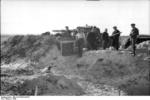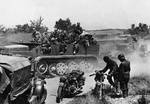8.8 cm FlaK 18/36/37 Anti-Aircraft Gun
| Country of Origin | Germany |
| Type | Anti-Aircraft Gun |
| Caliber | 88.000 mm |
| Weight | 4985.000 kg |
| Ammunition Weight | 9.40 kg |
| Rate of Fire | 15 rounds/min |
| Ceiling | 8.000 km |
| Muzzle Velocity | 820 m/s |
Contributor: C. Peter Chen
ww2dbaseForbidden to produce large caliber weapons, the first German 8.8 cm FlaK anti-aircraft guns were built in partnership with the Swedish firm Bofors. The prototypes were completed in 1928, designated FlaK 18. FlaK 18 guns were designed to be mounted on cruciform gun carriages, which allowed the guns to aim at any direction. Although they were heavy, they were still designed to become mobile relatively quickly, albeit requiring large vehicles for towing. They were also designed with a high rate of fire in mind, with the guns automatically ejecting spent shells so that the crews were spared of this task. While they fired high explosive shells against aircraft, they were also given anti-tank shells so that they could be used in an anti-tank role. Although FlaK 18 guns were only available in limited numbers, they quickly gained popularity. They were tested in action during the Spanish Civil War, which provided valuable information for the improvement of the design.The FlaK 36 anti-aircraft guns were the result. The design made use of a two-piece barrel for easier replacement of worn liners. The trailer design was also improved for quicker setup time, though the weight of the trailer had increased. The trailer design improvement was significant, as guns mounted on these new trailers could be dropped into firing position while they were still mounted on their towing wheels. This new feature allowed FlaK 36 guns to accompany fast-moving mobile offensive units that characterized the first years of the war in Europe and North Africa. In North Africa, they were also used to ambush Allied tanks to great effectiveness. It was around this time that 8.8-centimeter guns began to appear in in German cities. They were often deployed in multi-gun static anti-aircraft batteries, usually in groups of four guns each coordinated by a single controller. The next variant, FlaK 37, had its instrumentation improved to allow the commander of each battery-deployed gun to better follow directions from battery directors. As the 8.8-centimeter guns were improved, the designers attempted to keep the parts as interchangeable across variant designs as possible to improve logistics.
During the invasion of France, while the German tanks were out-classed by the heavier French counterparts, 8.8-centimeter guns were deployed in anti-tank roles against French tanks. In North Africa, they began to serve in anti-tank roles more often. They were reported on a few occasions to have penetrated over 150-millimeter of armor at a distance of 2 kilometers, making them very effective tank killers. When Germany invaded the Soviet Union in mid-1941, they continued to serve in the dual anti-aircraft and anti-tank role. As the war went on, however, they gradually reverted back to their original role as anti-aircraft guns in an attempt to counter the intensifying American and British air raids.
Informally, all 8.8 cm FlaK guns (including the FlaK 41 successors) were known by the German military as Acht-acht, 8-8.
By Aug 1944, there were 10,704 8.8 cm FlaK 18, FlaK 36, and FlaK 37 guns in active service.
Source: Wikipedia. ww2dbase
Last Major Revision: Apr 2010
8.8 cm FlaK 18/36/37 Anti-Aircraft Gun Interactive Map
Photographs
 |  |
8.8 cm FlaK 18/36/37 Timeline
| 14 Apr 1941 | Australian infantry outside Tobruk, Libya reported the sighting of a number of "long-barrelled guns on strange carriages". This was the first indication that the Germans were deploying the dreaded 88-mm anti-tank gun in the Western Desert (although on this occasion the guns were soon withdrawn when German infantry failed to create a gap). |
Please consider supporting us on Patreon. Even $1 per month will go a long way! Thank you. Please help us spread the word: Stay updated with WW2DB: |
Visitor Submitted Comments
2. Anonymous says:
8 Mar 2019 07:44:42 AM
How many tanks and air-crafts did this weapon take down?
8 Mar 2019 07:44:42 AM
How many tanks and air-crafts did this weapon take down?
All visitor submitted comments are opinions of those making the submissions and do not reflect views of WW2DB.
Change View
Desktop ViewSearch WW2DB

News
- » The Emperor of Japan Planned to Honor WW2-era Japanese POWs in Mongolia (4 Jul 2025)
- » US State Lawmaker John Winter Caught Using Racial Slur "Jap" and Apologized (11 Jun 2025)
- » Köln/Cologne Evacuated After Discovery of WW2 Bombs (4 Jun 2025)
- » Race, Holocaust, and African-American WW2 Histories Removed from the US Naval Academy Library (7 Apr 2025)
- » US Government Plans to Purge WW2 Information (17 Mar 2025)
- » See all news
8.8 cm FlaK 18/36/37 Anti-Aircraft Gun Photo Gallery
 |  |
Current Site Statistics
- » 1,178 biographies
- » 337 events
- » 45,089 timeline entries
- » 1,245 ships
- » 350 aircraft models
- » 207 vehicle models
- » 376 weapon models
- » 123 historical documents
- » 261 facilities
- » 470 book reviews
- » 28,490 photos
- » 365 maps
Famous WW2 Quote
"You ask, what is our aim? I can answer in one word. It is victory. Victory at all costs. Victory in spite of all terrors. Victory, however long and hard the road may be, for without victory there is no survival."Winston Churchill
25 Aug 2016 07:02:29 AM
By the outbreak of World War II the Germans already possessed almost two and a half thousand of these 88mm guns. Their lethality against armoured vehicles was aptly demonstrated during the Battle of France in 1940 where they proved to be the only gun capable of stopping the heavier French and British tanks - the standard issue 37mm Pak 35/36 proving to be totally ineffective, and the introduction of the 50mm Pak 38 was so slow that there was never enough of them. In Cyrenaica the 88's longer ranges was definately a bonus when well dug into static positions. This usage was not particularly appreciated by anti-aircraft commanders who did not like having their precious guns deployed in another role. Indeed, it was tantamount to losing them completely, since typically, the anti-aircraft fire-control equipment would be stripped off, rudimentary shields attached and the weapon generally rendered unfit for its primary role. But their effectiveness against the British armoured brigades in North Africa created a fanciful legend among the Desert Rats that every British tank knocked out was claimed to have been destroyed by an '88'.